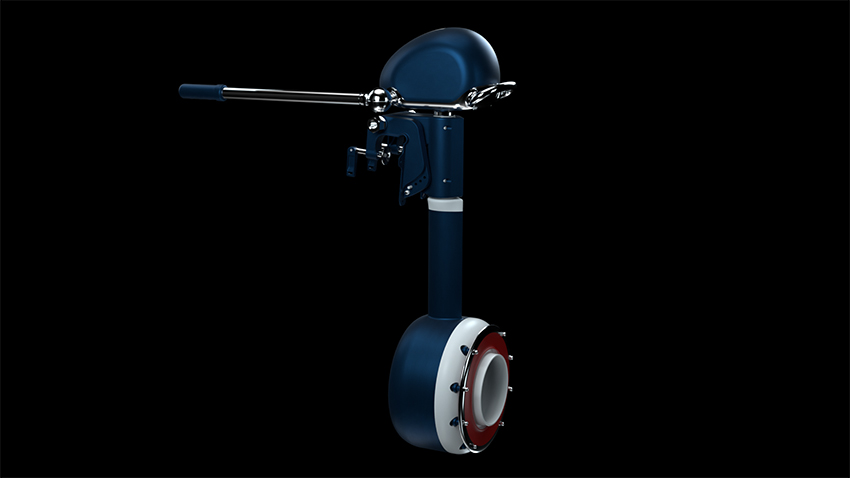The best way to preserve nature is to be inspired by it. Born of evidence and bio-inspired, FinX creates a world premiere: the first outboard engine composed of an undulating membrane that replaces the propeller, 100% electric, totally safe, inspired by fish swimming.
FinX has developed the Fin5, a 2kW breakthrough outboard engine, equivalent in thrust to a 5 HP standard engine, dedicated to small boats and sail boats up to 3 tons, for fresh and salt water.
The Parisian start-up is currently carrying out a second round of fundraising – Series A – in order to move on to industrialization and commercialization. FinX is also beginning the development of the Fin150 for the Olympics in Paris in 2024. The Fin150 (100% electric, totally safe, with fins and powered by hydrogen fuel cells), will be dedicated to bigger boats of 100 kW (equivalent to 150 CV).
FinX was born in summer 2019. Within only one year, Harold Guillemin has managed to unite around his ambitious project a team of ten people and many players in the nautical sector (including the worldwide known French sailor Loïck Peyron, godfather of FinX), all convinced that this technology will mark the beginning of a major revolution in the nautical industry.
This outstanding potential technology will take FinX even further. FinX will soon replace the propellers of boats, but will also become a leader in the energy transition, targeting other gigantic markets like pumps, by selling licenses to pump manufacturers of its product developed for the nautical industry.

Easy Engineering: What are the main areas of activity of the company?
FinX: A major (r)evolution is necessary and FinX meets the major needs of the nautical sector, providing key benefits. The undulating membrane technology that FinX has developed is totally safe (no risk of cutting or injury and the membrane does not get tangled in ropes), high performance, energy-efficient, quieter, very robust, and easier to maintain (very low maintenance, consisting of only a few parts). “We have adapted bio-inspired technology from medical pumps to marine propulsion. Our motor is completely safe, it is quieter than its thermal equivalent and does not emit any greenhouse gases, being electric,” explains Harold Guillemin, CEO and Founder of FinX.
The membrane, which vibrates and doesn’t rotate, undulates like a fish fin and propels the fluid in a straight line for better hydraulic efficiency. Furthermore, this technology is disruptive in shallow environments such as coral reefs and mangroves, where propellers, with their rotating movements, lift particles from the bottom and damage the aquatic environment.
FinX is establishing partnerships with boat rental companies throughout France. Many are interested in pre-ordering the engine, which they will receive once our first series is manufactured in the first quarter of 2022. This Fin5 is also used in other applications, through the sale of adaptation contracts and licences to manufacturers. Thus, the Fin5 is currently in demand by rental companies for boats without a licence, manufacturers/renters of nautical equipment, sailing schools and private individuals, but also industrialists in the maritime world (shipyards, equipment manufacturers, dronists, port managers, etc.). The Fin150 will be popular with workboats, river passenger transporters and private individuals.

E.E: What’s the news about new products?
FinX: FinX is beginning the development of the Fin150 for the Olympics in Paris in 2024. The Fin150 (100% electric, totally safe, with fins and powered by hydrogen fuel cells), will be dedicated to bigger boats of 100 kW (equivalent to 150 CV).
E.E: What are the ranges of products?
FinX: For the moment, Finx has 2 product lines, which will be expanded in the future: the Fin5, equivalent to a 5 HP combustion engine, and the Fin150, equivalent to a 150 HP combustion engine. In the future, FinX will develop more powerful electric motors up to 1000 HP.
E.E: At what stage is the market where you are currently active?
FinX: The world needs clean and sustainable transport. Polluting both air and water, the impact of the nautical and maritime sectors accounts for a large proportion of the total pollution generated on the planet. Marine pollution, resulting mainly from land-based resources through the use of fossil fuels, is reaching alarming levels.
Many players are dealing with this problem in the road sector, and the same is true of the aeronautical industry. But still too few innovations are emerging in the maritime sector, and above all, none are proposing to replace the propeller of boat engines with a more efficient solution. We are now realising that the propeller is a technology of the past… Firstly because it consumes a lot of energy, then because it is dangerous and costly, and because it disturbs fauna and flora because of the turbulence it creates.

So that’s FinX’s mission: to use innovation to create a hyper-compact membrane that undulates like a fish fin, and saves up to 30% in energy costs compared to a propeller. FinX boat engines are exclusively electric and do not emit GHGs. They can be powered by other energy sources in the future, reducing our dependence on fossil fuels. We want to prove that it is possible to create solutions for a world in which technological advances are compatible with the preservation of the marine ecosystem.
In the marine propulsion sector, although we have competitors with electric motors and the same power, our major difference is in safety.
E.E: What can you tell us about market trends?
FinX: Environmental awareness is still very low. A major overhaul’s just beginning in the yachting world and must be accelerated.
The electric boat market represents about 2% of the maritime sector worldwide and 1 to 2% in France according to the French Electric Boat Association (AFBE).
Hydrogen seems very promising for boating. The fuel cell has a lot of merits and can overcome the problems associated with electric batteries. Hydrogen can be produced on board with large units or stored with adequate tanks. The issue is the equipping of ports, which will need to be provided with sufficient storage and supply capacities.
Domestic and European investments are taking place. The demand for hydrogen could grow by 50% by 2030. To meet CO2 emission reduction targets, this hydrogen will have to be cleaner than the one currently produced, opening vast prospects for green hydrogen production markets. By 2030, new uses (including mobility) could represent up to 30 Mt of hydrogen demand.

E.E: What estimations do you have for 2022?
FinX: The industrialisation and marketing of the Fin5 are planned for 2022. At the same time, we will rapidly ramp up the Fin150.
As previously mentioned, last spring we won the “Paris 2024 Olympic and Paralympic Games” Call for Innovations, orchestrated by France Mobilités (attached to the Ministry of Ecological Transition), which wants to promote the green mobility of tomorrow, during the Olympic Games in Paris in 2024. In this context, we are expected to supply 5 Fin150 engines for passenger transport on the Seine during the Olympic Games.
The Paris 2024 Olympic and Paralympic Games are an extraordinary opportunity to showcase French know-how. France will be a showcase for innovation – and disruptive innovation – in mobility. This two-year adventure should allow us to showcase our ability to imagine tomorrow’s nautical travel.
We are currently a team of ten people and are aiming to double our workforce by 2022, at the end of our €5M Series A.

